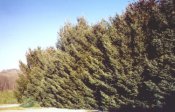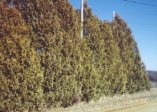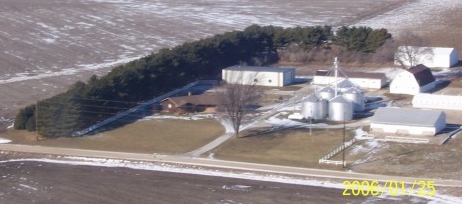This windbreak uses Techny Arborvitae, White Pine and Norway spruce. The curved rows are Techny Arborvitae, who says windbreaks have to be in straight rows?
Three row windbreak on the North and West side to protect a farmstead.
Three row windbreak with Red Cedar on outside, 16 ft inside to White Pine, and 16 feet inside to Norway Spruce. This windbreak is 12 years old.
We have Arborvitae along the road to the west, Arborvitae and Norway Spruce on the North side and Colorado Blue Spruce on the East side. I think spacing is too tight tight on this example for the long term.
The West side is the long side, and 2 rows of White Pine and one outside row was a honeysuckle. After 10 years the homeowner realized the honeysuckle was a mistake and removed them to put Arborvitae on the outside and then Norway Spruce next to the White Pine.
Here is a homeowner with roads on three side of his property. For privacy and a windbreak he has put 2 rows of spruce to surround his property on three sides.
Here is a 15 year old windbreak that has Techny Arborvitae on the outside Spaced 8 ft apart in the row. 16 feet from the arborvitae is the White Pine spaced 16 ft apart. 16 feet from the pine is a row of Norway Spruce spaced 16ft apart in the row. At the present time this windbreak is giving excellent protection but looking back it would have been better to space them 4 feet farther apart in the row and between rows, better for the long term.
Here is a field windbreak that is 15 years old and ½ mile long in Iowa. It is a total of 86 ft wide with Red Cedar on the outside (left side) spaced 8 ft apart. Next row is White Pine and European Larch spaced 10 ft apart in the row. Next two rows are hardwoods, 7 kinds of Oaks, Walnuts, Ash, Hickory, and Hackberry spaced 6 ft apart. On the inside (right side) is Norway and White Spruce spaced 12 ft apart. About ½ of these trees will be removed in the future a little at a time to give the others room to grow.
Newly planted windbreak in North Dakota, in Iowa and surrounding states we usually do not recommend using fabric for weed control but recommend herbicides. Fabric in our area is a home for mice, voles and rats and they eat the trees stems and roots in the winter.
We are looking North and have a row of Red Cedar and other evergreens to the east. They are quite thick so this picture is to show that with a thick outside row, as the snow and wind from the west, hits this first row it will create an area where the wind is decreased as it lifts up and over the Red Cedar. The result will be a snow bank occurring on the west side of the trees. This may be considered unusual as many people think all the snow drops on the leeward or downwind side of a windbreak. We estimate about 25% of the snow dropped here before going into the windbreak. As the trees get taller more snow will drop in this area.











